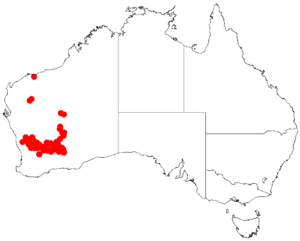Old-man wodjil facts for kids
Quick facts for kids Old-man wodjil |
|
|---|---|
| Scientific classification | |
| Genus: |
Acacia
|
| Species: |
resinimarginea
|
 |
|
| Occurrence data from AVH | |
Acacia resinimarginea is a type of tree or shrub. It belongs to the Acacia family, also known as wattles. This plant is special because it only grows naturally in western Australia. It's a unique part of the Australian landscape!
What Does Acacia resinimarginea Look Like?
This tree or shrub usually grows quite tall, from about 1.5 to 7 meters (5 to 23 feet) high. It stands up straight with strong trunks. Its young branches are smooth (that's what "glabrous" means!) and round. They also have sticky, resin-like ridges.
Like many other acacia plants, it doesn't have regular leaves. Instead, it has special flattened stems called phyllodes. These phyllodes grow upwards and are straight and thin, like a line. They are about 8 to 18 centimeters (3 to 7 inches) long and only 1 to 1.5 millimeters wide. Each phyllode has four sides, and the tips are slightly curved with a sticky, resinous line.
This plant blooms from August to October, showing off bright yellow flowers. These flowers grow in small, round or slightly oval clusters. Each cluster is about 6 to 15 millimeters long and packed with golden blooms.
After the flowers, seed pods grow. These pods are smooth and thin, like paper. They are straight but have bumps where each seed is. The pods can be up to 6 centimeters (2.4 inches) long and about 2 millimeters wide. Inside, the seeds are mottled brown and arranged lengthwise. They are oval-shaped, about 2.5 to 3.5 millimeters long, and have a small, crest-like cap called an aril at one end.
Where Does This Acacia Grow?
Acacia resinimarginea is found only in a large area of Western Australia. This includes parts of the Mid West and Wheatbelt regions. It often grows on gently rolling plains. You can usually find it in sandy soils, but sometimes it also grows in loamy soils. It often forms large groups where it's the only type of plant growing.
You can find this acacia from places like Perenjori in the west, all the way to Kambalda in the southeast, and up to Leonora in the north.

